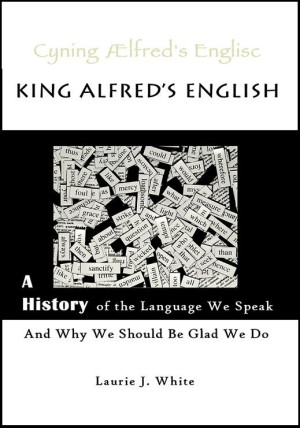This year I was looking for a way to teach my girls about the English language without teaching grammar itself. I wanted to give them an understanding of its beauty and history so that they would learn to love it and also be able to use it more skillfully. And then I was offered King Alfred’s English to review. What a perfect resource to meet those needs!

King Alfred’s English
In King Alfred’s English, Laurie J. White combines a study of history, linguistics, English literature, and the English Bible to show us the miracle of the language we speak. From Caesar in 55 BC through Old, Middle, and Modern English, she traces native and foreign influences on the English language and shows how they affected both the structure of our language and its vocabulary.
The subject material itself is fascinating, with section titles such as
- Fighting Druids,
- How Do You Un-Invite a Jute,
- Language—Evidence for Design,
- From Saxon Runes to Roman Alphabet,
- The Original Meaning of Berserk,
- Losing our Gutterals,
- The Mystery of English Spelling,
- Scriptures for a Ploughboy,
- Heads Begin to Roll,
- Shakespeare in a Psalm,
- Those Lingering Pronouns for God,
- How Words Morph and Mutate.
Laurie’s writing is enthusiastic and clear, full of examples, quotations, and illustrations. The timeline she has developed is a brilliant outline of English history, simple enough to memorize easily yet broad enough to serve as a framework for all the many details. And details there are, each one more fascinating than the next. Occasionally we even got lost in them.
But there is more. With Laurie’s other resources, it is easy to use this book into a course. King Alfred’s English is written for grades 7-12 and can be either a part of an English or history course or a full semester course in either subject. There are online worksheets and tests with answer keys if you want formal marks. Laurie also recommends other resources such as videos clips, websites, and movies. If you want this to be a full course you will need to take advantage of many of these resources and probably add some writing. We enjoyed video clips about building Hadrian’s wall, paged through the Book of Kells, researched the Rosetta stone, ‘walked’ around Stonehenge, and more, and will be using this resource list in the future for other history, church history, and literature courses.
The fact that Laurie is a Christian shines through her book. The English language is, after all, very closely linked with the history of Christianity in England; seeing all this through the eyes of a Christian is a special treat. And, to my amazement, even the languages of the world show evidence that we were created by design, not chance. (Shortly after we studied that concept in King Alfred’s English, I heard the same thing discussed at the Dig and Delve Conference for college students.)
The girls have learned a lot about history, reviewed things they learned from The History of English Literature for Boys and Girls, and studied the intricacies of language development. Our time spent with King Alfred’s English has been rewarding in every way.
We recommend King Alfred’s English as a ‘living book’, suitable to teach and inspire simultaneously. It could be used as a welcome break from grammar, an interesting addition to history lessons, or just a book to read for fun. The content is important, God-honoring, and, with the resource list, can be adapted endlessly. I think every homeschooled teen would benefit from this course.
Disclosure: I received a review copy of this book from Laurie J. White, and have expressed my own honest opinions.
You will also enjoy Eva’s review of King Alfred’s English
-originally published April 2016

Enjoyed reading your review. Sounds like it would fit in well after Marshalls’s History of English Lit.